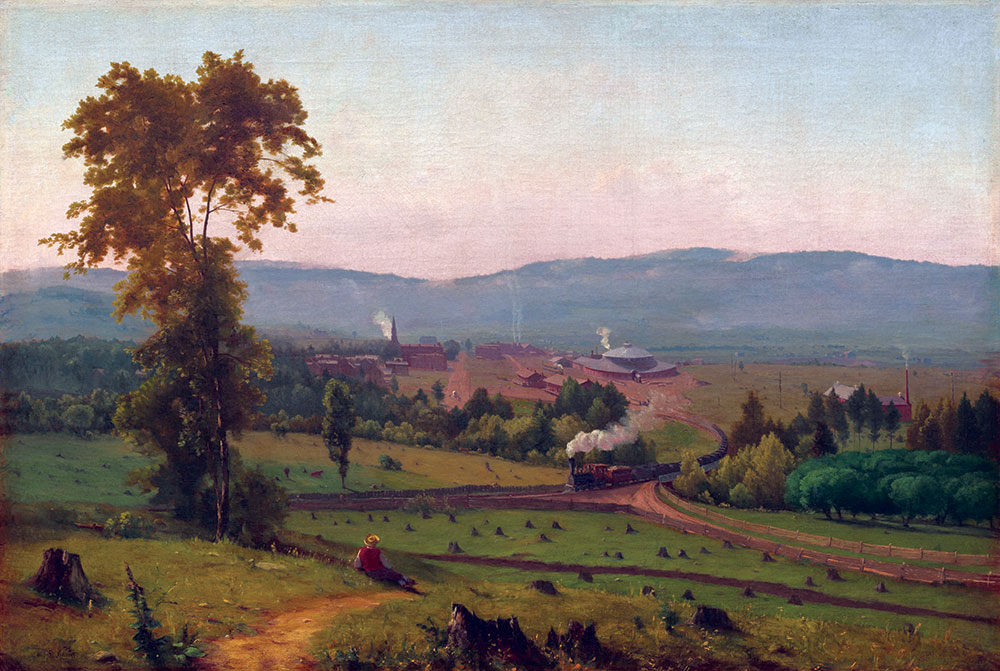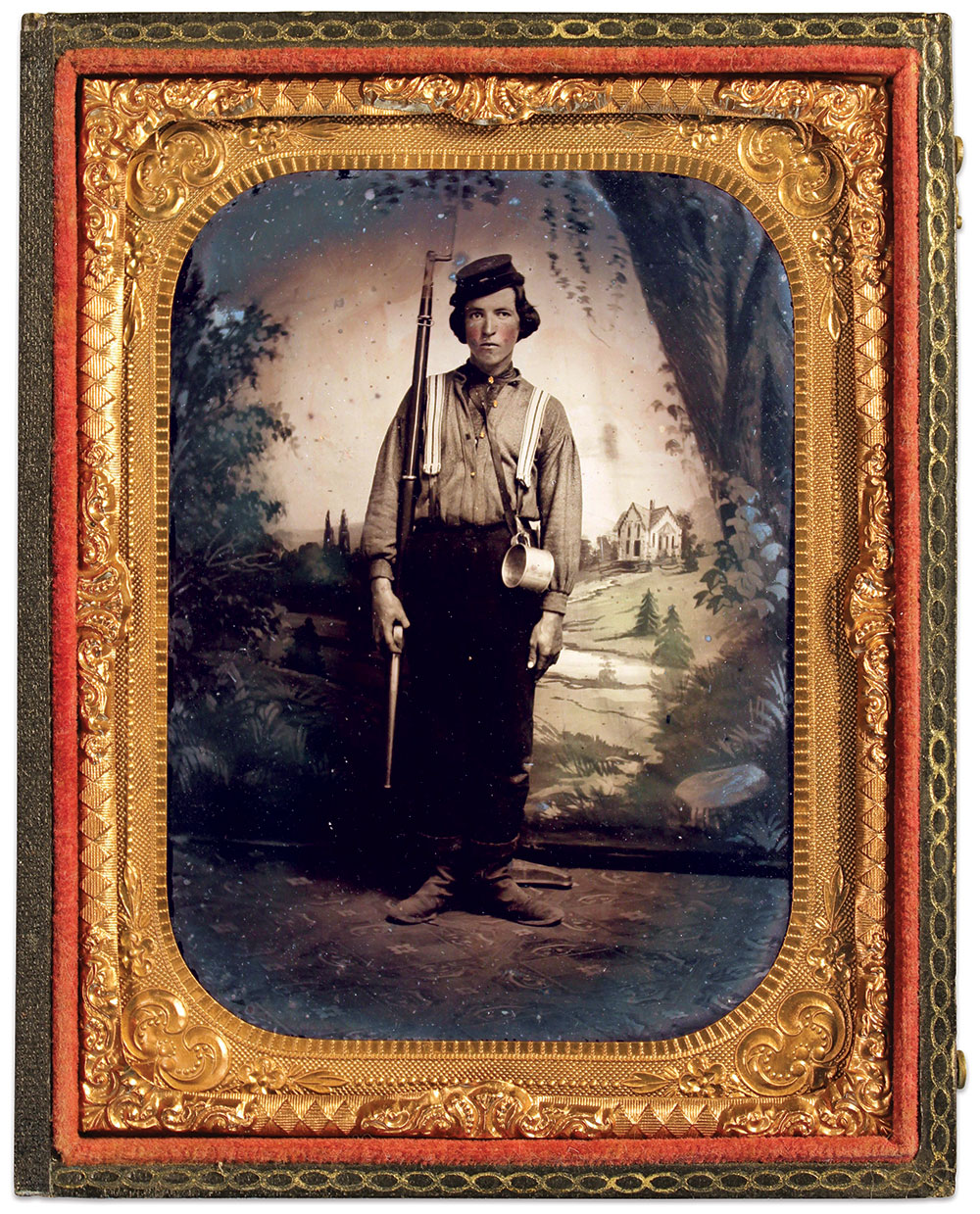By Adam Ochs Fleischer
In this installment, we examine a painted backdrop that does not have a military theme. Before the Civil War, landscape painting as a genre dominated American art. The rich bounty of New World scenery provided excellent source material for artists associated with the Hudson River School, a movement best known for its idealized portrayals of the American landscape. Considering the artistic predilection of the time, it is unsurprising to see a number of painted backdrops used in Civil War portraiture which invoke the Hudson River School aesthetic. Though they are generally less impressive with respect to artistic merit and always lack realism, the spirit of harmony between nature and settlement that flavored the Hudson River School is often present in period backdrops. The subject of this column, the “House Near the Susquehanna,” is a representative example.

Selinsgrove and Sunbury, Pa.

The House on the Susquehanna backdrop was used by the photographic firm Kern and Gaugler, which likely operated in both Selinsgrove and Sunbury, Pa., during the war years. Both towns are located in central Pennsylvania and sit on the shore of the Susquehanna River. A small, picturesque town with just over one thousand residents in 1860, Selinsgrove also hosted a Lutheran seminary school, which is now Susquehanna University. While not a major hub of activity before or during the war, the town had a local newspaper and a handful of prominent residents. Sunbury, located about a dozen miles north, was more active in 1860. A stop on three different rail lines, the town served as home to a number of different manufacturers, distilleries, hotels and foundries before the war.
The identification of this backdrop’s location will be of particular interest to military image collectors and researchers because of Selinsgrove and Sunbury’s remote location. Only one infantry company was principally raised in each town, Company G of the 147th Pennsylvania from Selinsgrove and in Sunbury, Company C, the “Sunbury Guards,” of the 47th Pennsylvania. While men from the greater area also enlisted in other regiments, the House Near the Susquehanna will give an immediate place to begin research that might prove useful in identifying a sitter.
Kern and Gaugler
 Research proves Kern and Gaugler a bit of a mysterious duo. Kern is undoubtedly William T. Kern (1838-1876), who is described in an obituary as operating as a photographer for a number of years in Selinsgrove. At some point not long after the Civil War, he must have relocated to Logansport, Ind., where he died in 1876. He is mentioned several times as having become a very successful merchant there. Gaugler has not yet been definitively identified. A somewhat prominent family that lived in the area with the same surname must have been related to the photographer.
Research proves Kern and Gaugler a bit of a mysterious duo. Kern is undoubtedly William T. Kern (1838-1876), who is described in an obituary as operating as a photographer for a number of years in Selinsgrove. At some point not long after the Civil War, he must have relocated to Logansport, Ind., where he died in 1876. He is mentioned several times as having become a very successful merchant there. Gaugler has not yet been definitively identified. A somewhat prominent family that lived in the area with the same surname must have been related to the photographer.
How Kern and Gaugler met and how they received photographic training is unknown. Their partnership must have been a short-lived arrangement, since all surviving examples of their work are tintype and carte de visite photographs, none taken after 1866. Their imprint on the reverse of surviving cartes de visite reads “Kern & Gaugler, Selins Grove, Pa.,” but it has been difficult to find evidence of the two actually operating together there. Newspaper advertisements beginning in 1864 describe them as having a studio in Sunbury. Since many of their cartes de visite marked Selinsgrove bear tax revenue stamps that date them to 1864-1866, it would seem the pair had studios in both towns, or perhaps continued to use an old stamp in the new studio.
Though not many examples of Kern and Gaugler’s work exist, their images appear well executed. Several incorporate a landscape format. Most impressive is the use of color on their tintypes. Every example examined, including the one illustrated here, has been richly decorated with pastel green, red and pink.
The Backdrop
The House Near the Susquehanna backdrop is a romantic depiction of a home on farmland near the woods. A large tree in the immediate foreground of this bucolic scene frames the subjects who stand before it. Unlike patriotic and military themed backdrops undoubtedly produced after the onset of hostilities, this example could have been made before the Civil War, though it was definitely used after 1861.
Special thanks to Michael Helfrich for his assistance in researching the House on the Susquehanna backdrop. Michael discovered several cartes de visite which made this article possible.
Adam Ochs Fleischer is a passionate researcher of Civil War photography and an admitted image “addict.” He began collecting in high school and quickly became obsessed. He lives in Columbus, Ohio.
SPREAD THE WORD: We encourage you to share this story on social media and elsewhere to educate and raise awareness. If you wish to use any image on this page for another purpose, please request permission.
LEARN MORE about Military Images, America’s only magazine dedicated to showcasing, interpreting and preserving Civil War portrait photography.
VISIT OUR STORE to subscribe, renew a subscription, and more.

